| February
6, 2007
Presenting: A History Tour of the Beach and
a Mission of Mercy with Gene Domagala
Gene Domagala is not only a key
volunteer in the Beach, an individual who helps out with all sorts
of charities and non-profit organizations - a “utility man”
as Bob Murdoch from Centre 55 calls
him – he is also one of the most knowledgeable individuals
about the Beach. So in late December we had covered the western
end of Queen Street East; today we were going to have a look
at the eastern and northern end of the neighbourhood.
We met again at the Beaches Library,
a great meeting point right in the heart of the Beach, at the intersection
of Queen Street and Lee Avenue. Gene let me know that he had been
notified this morning that the furnace of a local resident in the
East end of the Beach had broken down, so our neighbourhood tour
would also have to be a “mission of mercy” to deliver
a few portable heaters to this family in need. So the first thing
we did was to pick up three space heaters and drive into the east
end of the Beach close to the Balmy
Beach Club to drop off the heaters at a stately older home.
Gene promised to be back later today to deliver a few additional
heaters in order to make sure that the pipes in the house would
not freeze since the furnace would not be fixed until tomorrow.
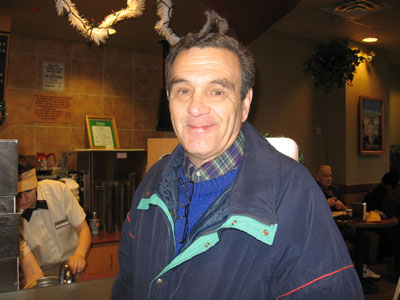
Gene Domagala - a pillar of the Beach Community
Gene explained that the Beach community is equipped for these sorts
of emergencies; there are always a few extra heaters floating around,
and Centre 55 keeps about 10 sleeping
bags for critical cases when someone needs to stay warm overnight.
A network of people looks out for their neighbours and makes sure
they stay safe and healthy, even in the deep freeze that Toronto
has been in for the last few weeks.
Since we were already in the east end of the Beach we decided to
start our explorations right there. Gene explained that about 120
years ago there was a little village here with a local pastor whose
name was H. Dixon. He started a tent church (literally a church
located in a tent) and ran it from about 1880 to 1907. The tent
church could hold as many as 500 people. Reverend Canon Dixon, as
he was respectfully referred to in later years, was committed to
ministering to the poor and founded missions and soup kitchens for
the homeless. This tent church was later to become a permanent building
– St. Aidan’s Church, which
just recently revived Canon Dixon’s legacy with its participation
in the Out of the Cold Program.
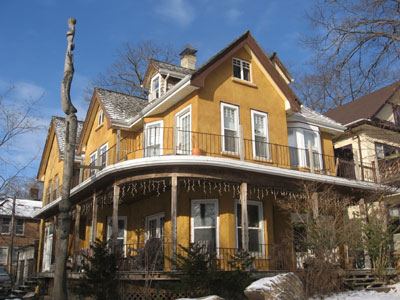
The former Alexandra Hotel Annex
We drove down on Balsam Street, and Gene showed me six houses that
originally date back about 110 years, beautiful wooden clapboard
properties with unique architectural features. At the bottom of
Balsam Avenue is the former Alexandra Hotel Annex, today a private
residence. Gene explained that about a century ago there were substantial
homes along the bottom of Fernwood Avenue which used to be called
“Lakefront Avenue”. The Alexandra Hotel had more than
30 rooms, and two free standing additions were built: Annex 1 and
Annex 2. The entire complex was a summer hotel and featured a boat
house at the waterfront and little cottages in the back. In the
1890s tourists would come from downtown Toronto by streetcar to
enjoy the beautiful waterfront experience in Toronto’s
Beach neighbourhood.
Most of these buildings were torn down around 1929 or 1930, but
the old Alexandra Hotel Annex remained and recently underwent a
beautiful renovation. There were several influential historic figures
in this area: Sir Adam Wilson - the first elected mayor of the City
of Toronto, a prominent jurist and a major landowner in the Beach;
Reverend Dixon; James L. Hughes who was also the Chief Inspector
of the Toronto School Board, and John McPherson-Ross, the Mayor
of East Toronto which included Balmy Beach.
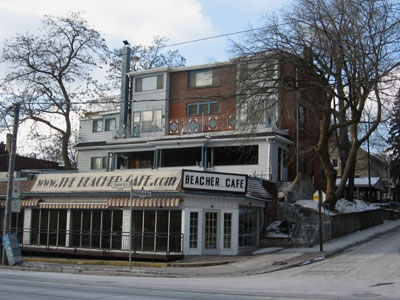
Former home of Alan Maclean Howard
Our historical tour continued toward another historical intersection
in the Beach: the intersection of Maclean Avenue and Queen Street.
In the second half of the 1800s Alan Maclean Howard was one of the
major landowners in the area. An interesting detail of his history
is that his father was a clerk at the law courts in Toronto for
51 years, and his son held the same position, also for 51 years.
A relative of Alan Maclean Howard was the first Postmaster of Toronto
and a United Empire Loyalist.
Gene explained that Howard was a bit of an eccentric: he imported
Guernsey cows and showed them at various agricultural exhibitions.
He also had three large ponds with Peking ducks on his country estate
which was called Glen Duart. Driving up on Hambly Street, Gene pointed
out that this street at one point was supposed to be as wide as
Spadina Avenue. Our drive continued north along Lee Avenue where
Gene mentioned that this was the western end of another major estate
in the Beach: the Glen Stewart Estate, owned by Alfred Earnest Ames.
This self-made millionaire was the youngest president of the Toronto
Stock Exchange, and at that time many successful stockbrokers and
business people had beautiful mansions on Sherbourne and Jarvis
Streets in downtown Toronto. In addition, they would also have summer
homes in the Beach.
The Glen Stewart Estate starts north of Williamson Road, while south
of this street was the location of the Glen Duart Estate. Ames had
bought the Glen Stewart Estate in 1899 from a certain Walter Stewart
Darling who was a minister in the area. Alfred Earnest Ames also
had two duck ponds on his estate, and a white picket fence surrounded
the entire expansive property. A twelve foot embankment bordered
the property east of Lee Avenue, this embankment was later levelled
after Ames had sold his property and it was divided up into a residential
subdivision. The Glen Stewart Estate ended at Kingston Road.
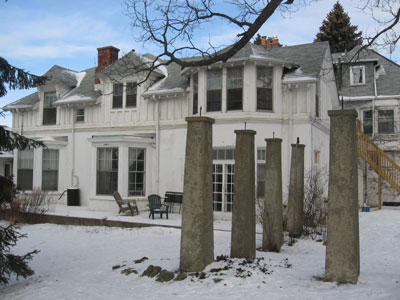
Former mansion of Alfred Earnest Ames
The main entrance to the Glen Stewart Estate was on Glen Stewart
Crescent where Alfred Earnest Ames’ residence was located.
Gene took me to the property which is a large mansion that has been
converted into a multi-unit apartment building. The mansion has
lost quite a bit of its former glory, but when you look at it closely
you can still picture the beautiful and imposing villa that it once
must have been. In 1906 Canada’s Governor General stayed here
for one week to attend the Queens Plate held at the old Woodbine
Race Track, an event that attracted thousands of horse-racing fans
from around the country.
Behind the mansion is a steep drop off, and in the ravine below
the crest Alfred Earnest Ames built one of the first golf courses
in Toronto in 1920. Before the construction of the golf course this
part of the property had consisted of woods and ponds. Alfred Ames’
stables were located just below the crest on Long Crescent.
A small dead-end street called Leonard Circle is the former location
of the Glen Stewart Estate’s ponds, and some of the houses
on this street are actually built on stilts, a necessary construction
technique due to the marshy ground. The ponds went all the way to
the north end of today’s Williamson Road School, and Gene
explained that around 1912 at least three or four boys died in the
pond. The back entrance of the school was the main entrance to the
palatial Glen Stewart Estate. The houses west of Lee Avenue were
not part of the Glen Stewart Estate; they were built in the 1920s
while the houses east of there on the former estate were put up
in the 1950s.
Southwood Drive, the extension of Main Street south of Kingston
Road, was the borderline between the Glen Stewart and the Glen Duart
estates. East of Southwood Drive there was only bush. When Alan
Maclean Howard moved out around 1915, the property was subdivided
and houses went up on Glen Manor Drive East. Today’s Glen
Stewart Ravine was the location of several ponds that were located
on the former Glen Duart Estate. Gene added that the ravine should
really have been called the Glen Duart Ravine since it was part
of Alan Maclean Howard’s estate.
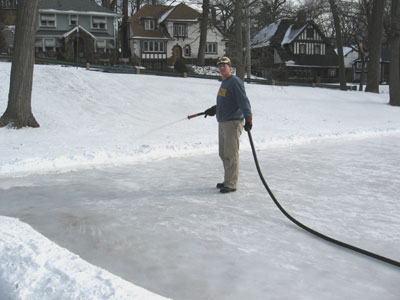
Thomas Neal is working on the maintaining the natural ice rink
As we were driving south along Glen Manor Drive, we stopped at
the natural ice rink that is maintained by local Beach residents.
Gene introduced me to Thomas Neal, a local real estate agent, who
dropped by a few years ago to take his boys skating and realized
that the rink had been closed down due to municipal funding cuts.
Together with Brock Grant, another neighbour, he decided that the
community would run the rink itself, and ever since then the two
men with the help of other neighbours, have been maintaining the
natural ice rink on a daily basis.
Brock and Thomas take turns, and Thomas alone spends about five
hours a day maintaining the ice rink. When I got there Thomas had
just hooked up a big hose to the water supply and was spraying the
rink with water which was freezing fast on this chilly day. After
every snow fall he and several like-minded volunteers come out to
shovel the rink. Now there are two sides to this natural ice rink:
one side is designated for hockey players and one side is for pleasure
skating. Thomas said that even Guy Lafleur once visited this natural
ice rink. He added that he loves maintaining the rink, it is great
for the kids, and at night the facility turns into a beautifully
lit venue.
The community spirit is strong here, and Thomas Neal is just another
example of how regular citizens pitch in and help out in the Beach.
I let Thomas continue his work, and returned to Gene who pointed
out a wooden bridge that crosses the Glen Stewart Ravine which has
been there since 1915. The bridge will be replaced by a new model
in the near future, but Gene, with his love for history, adds that
he would love to hang on to the original one.
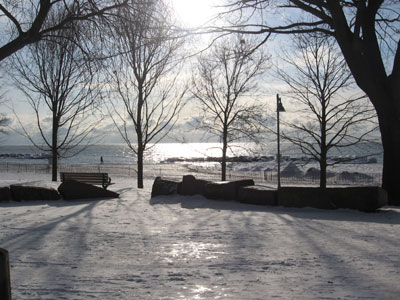
A freezing winter day in the Beach
Ivan Forrest Park, at the southern terminus of the Glen Stewart
Ravine, was named after a Parks Commissioner of the City of Toronto
from the Second World War. Alan Maclean Howard’s ponds were
finally diverted into pipes which carried the water into Lake Ontario.
Further north, the natural part of the Glen Stewart Ravine stretching
towards Kingston Road has not changed much throughout recent history.
Gene explained that the ravine is a favourite destination of naturalists
and bird lovers because of the large variety of bird species and
indigenous plants.
From the Glen Stewart Ravine we crossed Queen Street southwards
and arrived at the former location of the Scarborough Beach Amusement
Park, a development that was started in 1906. The former owners
of this parcel were the Sisters of St. Joseph who ran the “House
of Providence Farm”, a specialized school for people with
disabilities, in this area.
Revellers would come from the city in street cars of the Toronto
Railway Company; these used to turn down on Scarborough Beach Boulevard.
A giant velodrome used to be located just west of this street, and
the street car would end at the bottom of Scarborough Beach Boulevard.
Further south near the Hubbard Apartment Buildings used to be the
midway with a giant Ferris wheel and 125 foot high tower that was
lit nightly with thousands of electric lights. The tower was also
used for a variety of stunts by different performers. The Scarborough
Beach Amusement Park also included a quarter-mile long roller coaster
ride, and different attractions such as a “Tunnel of Love”
and a “Shoot the Chutes” flume ride. The first boardwalk
in the Beach ran from the Hubbard Street apartment building to Fernwood.

Historic plaque, commemorating the Scarborough Beach Amusement Park
At the bottom of Scarborough Beach Boulevard is a historic plaque
that tells the story of the amusement park. As an expert in and
advocate of local history, Gene Domagala has been lobbying for historical
preservation in the Beach for many years, and was able to get six
historic plaques installed in this area. The plaque commemorating
the Scarborough Beach Amusement Park is one of them.
After the amusement park closed down in 1925 the land was bought
up by developers; among them were the Price Brothers, a team of
Toronto-based real estate developers who created more than 200 houses
in the area, among them a whole section of architecturally unique
fourplexes characterized by their front porches and arched verandas.
Several of these fourplexes on Wineva Avenue have been listed on
the City of Toronto’s Inventory of Heritage Properties as
a result of their unique design.
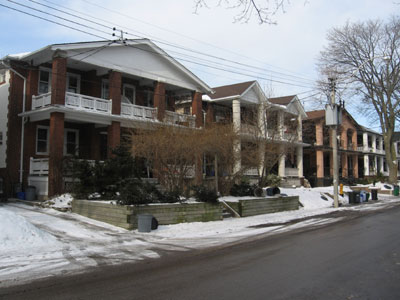
The Price Brothers Development
Our drive continued further east, and at the intersection of Maclean
and Queen Streets Gene pointed out a historical property: the elevated
building behind the Beacher’s Café is actually the
original location of Alan Maclean Howard’s residence, although
it has been modified a great deal over the years. Gene had been
looking for it for a long time and could not find Howard’s
original house. He realized that the street numbering on Queen Street
had changed several times, and he had finally found the original
house of Alan Maclean Howard. We drove north of Maclean Avenue and
arrived on a winding, hilly road called Pine Crescent. This is the
only area in the Beach where there is brick pavement. Gene explained
that several neighbours came together and pitched in to get a historic
reconstruction of brick pavers installed in their road. At the top
of the hill is a beautiful private residence called “Pinecrest”
which dates back to 1902 and was designed by renowned architect
Charles Frederick Wagner, who had also created the well-known Inglenook
property on Waverly Road.
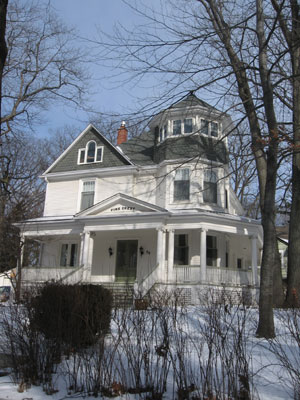
Pine Crest
Across the street is a mansion formerly owned by Joseph Harris,
a member of the Canadian Parliament. We then drove up towards Kingston
Road, past Glenn Gould’s birth house on Southwood Drive. Glenn
Herbert Gould (1932 to 1982) was a celebrated Canadian pianist and
became especially well known for his recordings of Johann Sebastian
Bach’s keyboard music. Gene added that Gould was almost better
known in many countries around the world than he was in Canada.
A historic plaque educates visitors about the life of this outstanding
Canadian musician.
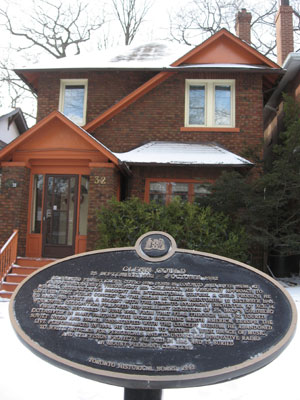
Glenn Gould's childhood home
Once arrived on Kingston Road we drove by the Notre Dame Convent
which also houses a local Roman-Catholic school. This area used
to hold the car barns for the Toronto Street Railway Company. We
drove into the neighbourhood north of Kingston Road and turned left
on Swanwick Avenue. Gene started explaining to me that this entire
area used to be called the Village of East Toronto. Just up the
street were the largest freight yards of the Grand Trunk Railroad
which included marshalling yards, coal storage facilities and a
roundhouse. The area near Gerrard and Main Street was a center of
railroad activity in the late 1880s until the early 1900s. About
300 to 400 workmen were employed here, and many of the houses were
built for these railroad employees. In total the Village of East
Toronto had about 5000 residents.
Gene added that many of these employees were rather transient,
they would often move from job to job, depending on the opportunities
that presented themselves. There was a problem with the freight
yards, however: the steep gradient from downtown Toronto to the
Village of East Toronto necessitated three locomotives, three firemen
and three engineers in the moving of the trains. Because of this
unsuitable topography the CN freight yards closed down in 1908 and
relocated to Belleville and Etobicoke respectively, a move that
plunged the area into a serious long-term economic decline.
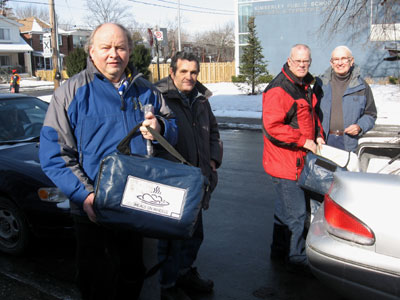
Bob Murdoch and volunteers work on the Meals on Wheels deliveries
We continued our drive and stopped at Centre
55 where Gene briefly connected with Bob Murdoch. The Meals
on Wheels deliveries were in full swing, and Bob and several of
the volunteers had their hands full. From there we continued to
Gerrard Street where we briefly dropped in at the offices of the
Beach Metro News. The
new edition of the paper had just been printed, and several of the
captains had come in to pick up their many bundles of paper to pass
on to their volunteers who look after the street delivery of the
paper. As Gene also volunteers as a captain with the Beach Metro
News he picked up his bundles of paper, and then we continued our
historic drive.
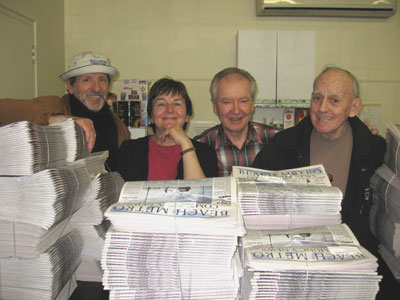
Newspaper distribution day at the Beach Metro Community News
Our conversation went back to the historic significance of the
Main and Gerrard area. Gene added that there were three major intersections
in the Beach: Queen and Lee, Queen and Beech as well as Main and
Gerrard. He explained that the area featured a farmer’s market
and a mix of smaller townhouses and nicer homes. At the corner of
Enderby Road and Gerrard Street is a house that used to be owned
by a man named Donald George Stephenson. He was a lumber merchant
with a physically imposing appearance who was also the mayor of
East Toronto. He was well known for his overspending ways, and in
1894 he built a series of row houses on Norwood Terrace, but ended
up accumulating major debts and in the end he pulled a disappearing
act to escape his creditors.
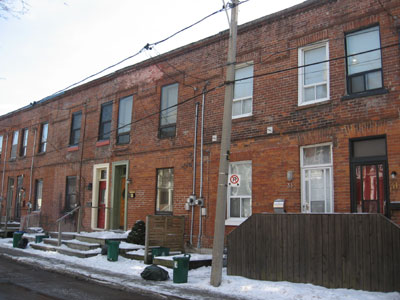
Working class townhouses built by Donald George Stephenson
Behind Norwood Terrace today is the Main Street Bridge which used
to be a wooden trestle bridge during the 1920s, spanning eight railway
tracks. The area around Main Street was a thriving commercial hub
with its own farmer’s market, diverse retail stores and several
theatres. One of these theatres was the Ideal Theatre which today
is a local retail store. The YMCA used to be on the other side of
the intersection where the Ted Reeve Arena is today. Several banks
were located at the Main and Gerrard intersection. A hospital and
a library were nearby. This was the real centre of East Toronto.

Beautiful house on Swanwick Avenue
From this area we drove south to the intersection of Main Street
and Benlamond Avenue, another historical centre. Gene explained
that Main Street used to be called Dawes Road in this area. Following
Benlamond Avenue into an old established neighbourhood that used
to be blocked to the public by a gate, Gene told me about the business
owner duo of Benjamin Morton and James Lamond Smith who were both
bankers with the Bank of Upper Canada. They were major landowners
in this area. Swanwick Avenue, a local street, was named after Mary
Swanwick Morton. Together these two business men created the first
golf course in Toronto in 1871 near Woodbine and Coxwell Avenues,
just north of the St. John Norway Cemetery. On Glen Oak Drive near
Norwood Park there are several large stately homes dating back to
the 1940s and 1950s. There is no through traffic in this area, and
this little nook is virtually unknown to most Torontonians. The
house of Edward Lyall Morton, Benjamin Morton’s son, is in
this neighbourhood, and some of the nicest houses are located on
small side streets at the edge of an escarpment with a beautiful
view over the Beach and Lake Ontario.
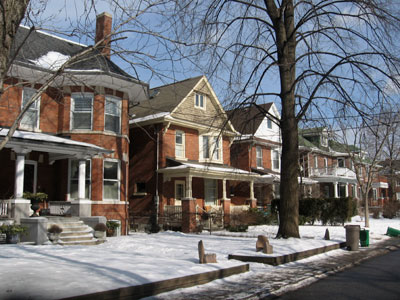
Historic Lyall Avenue
We came back out on Benlamond Avenue where the food bank at Calvary
Baptist Church was in full swing. Gene added that this church features
a beautiful stained glass window. Reverend Sneyd collected windows
from bombed out churches in Europe after World War II and put them
together into one giant stained glass window that was installed
in the 1970s. We then drove east on Lyall Avenue, and Gene informed
me that the first 60 houses on both sides of the street are actually
protected as part of a designated heritage area. These homes were
built for middle class families who had settled here permanently
in contrast to some of the other lower income housing that was built
for the more transient population of railway workers. Gene pointed
out a unique feature of this neighbourhood: several street corners
have houses with large front yards, an unusual sight in Toronto’s
older high-density neighbourhoods. Gene referred to them as the
“fifty-fifties”: the front yard measures fifty yards
by fifty yards, and the houses are set in from the street.
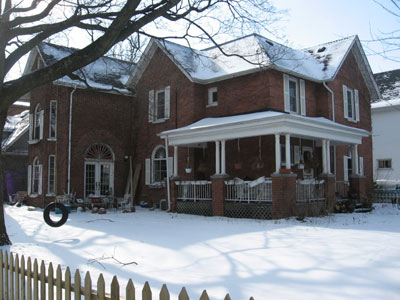
A "fifty-fifty" property, inset from the road
Our next brief stop during our tour was at Malvern Collegiate,
a venerable educational institution since 1903. Malvern is one of
Toronto’s top academic high school and counts such illustrious
graduates as Glenn Gould, Robert Fulford and Don Getty. Other celebrity
students at Malvern include Norman Jewison, Alex Trebek, Keanu Reeves,
Kiefer Sutherland and Jack Kent Cooke. The impressive library wing
addition on the west side of the building opened in 1987 and features
a statue that dates back to the First World War.
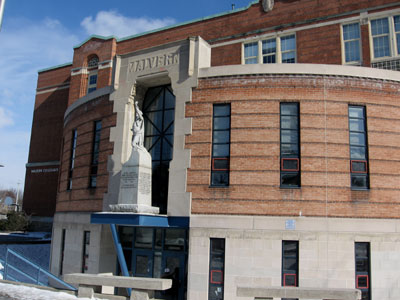
Malvern Collegiate Institute
From here we headed down on Hannaford Street to Kingston Road where
Gene showed me a local convenience store that used to be “Ritches
Dairy” – a stone insert in the building’s façade
still testifies to the agricultural heritage of this area. Gene
added that about a dozen dairies were located here about a hundred
years ago, and he explained that there was nothing on the south
side of Kingston Road until the 1940s.
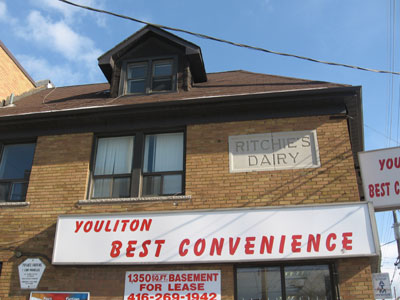
The former "Ritchie's Dairy"
Kingston Road was not a thriving business area at that time, as
a matter of fact there were still agricultural operations in the
area including several chicken farms. Near Balsam Road and Beech
Avenue we reached the end of the Village of East Toronto. This area
was built up in the 1920s and had two theatres. The Kingston Road
United Church at the intersection of Scarborough Road is a historic
anchor in this area; and the Pegasus Thrift Store, Marie
Perrotta’s charity thrift shop, is located almost directly
across from the Kingston Road United Church.
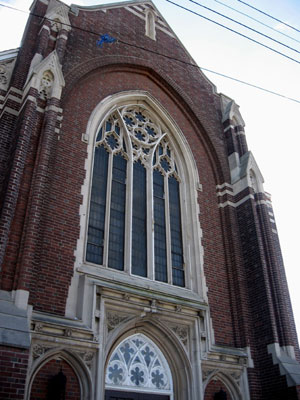
Kingston Road United Church
A little ways east we stopped the car and headed into the local
Scotiabank Branch at Kingston Road and Bingham which has about an
80 year history. Gene wanted to introduce me to the Branch Manager,
Carolyne Pitre, who also helps to run the Kingston
Road Business Community. The entire Kingston Road area between
Main Street and Victoria Park has been undergoing extensive revitalization
over the last few years with new specialty retailers, galleries
and hospitality businesses moving in. The popularity of the Beach
as a neighbourhood has attracted many investors and new residents
to the area. While at the bank we also ran into Hong
Zhao, Publisher of the Beaches Community Living Guide, another
one of my interviewees. What a small world Toronto can be….
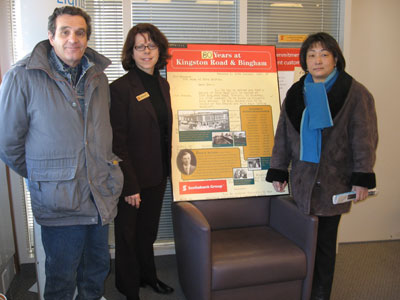
Gene Domagala, Carolyn Pitre and Hong Zhao
After our brief visit we went east to Victoria Park Avenue where
we turned south. The forerunner of today’s Roman Catholic
Neil McNeil High School used to be St. John’s Industrial School,
a school for “bad boys”. This school operated roughly
from 1890 to the 1950s when the new Neil McNeil High School was
built. As we drove towards Lake Ontario on Bracken Avenue with beautiful
views opening up over Neville Park Road, Gene added that he has
seen major changes in Lake Ontario’s shoreline in the last
40 years. The lake and the Beach neighbourhood itself are in constant
flux, but one place that remains after almost a hundred years is
the Fox Theatre in the eastern end of the Beach. Originally built
as the Prince Edward Theatre in 1913, today the Fox is the longest
continuously running movie theatre in Toronto and one of the oldest
movie houses in all of Canada. Across the street, Quigley’s
Pub and Bistro is the former Ross’ Drug Store which dates
back to 1902. The Wholesome Market on the east side of Queen and
Beech used to be a bank in former years. Gene added that vaudeville
was being performed in Munro Park until 1906, so this area was one
of the entertainment centres in the Beach.
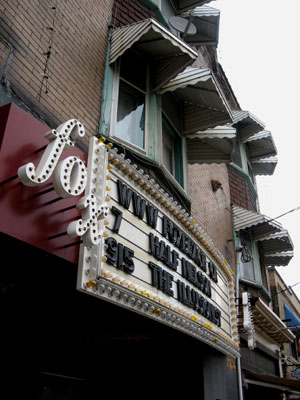
The Fox, an institution in the Beach
We drove north on Beech Avenue to a small street called Pine Terrace
which features a long east-west facing building that is set in from
the street that is totally different from the rest of the residential
architecture. Gene informed me that this building used to be a summer
hotel and was built by William Williamson, a well-known builder
and land developer more than a century ago. The hotel is part of
the Beach' resort town history.
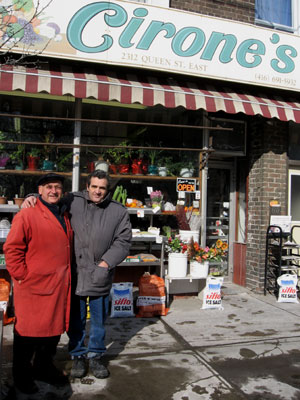
Cirone's Food and Joe Cirone, also a fixture in the Beach
From there we made a stop at another local neighbourhood fixture:
Cirone’s Foods, a neighbourhood grocery store that is really
a miniature sized all-round store for anything that a local resident
might ever need. Gene and I stopped by to meet the owner, Joe Cirone,
who has been operating this store since 1966. Joe is a real character,
and once you get to know him he freely shares stories of his childhood
which happened around this neighbourhood as well. Gene explained
that although Joe has done very well he has always maintained his
loyalty to the Beach and continues to operate his business here.
His roots are solidly anchored in the Beach.
So, a history tour that was supposed to have taken a couple of
hours had lasted from 9 am until about 2:30 pm. Not only was I quite
frozen and ravenously hungry, I had learned so much about different
areas of this neighbourhood that are just literally five, ten minutes
from my own house. Gene had opened my eyes to a whole new universe
just outside my door step, a universe full of interesting people
and fascinating stories that stretch back almost a century and a
half. I really appreciated Gene’s time and all the knowledge
he had shared with me. I had a feeling I was only scratching the
surface of Gene’s historical expertise of the area since he
had in-depth knowledge of probably every block that we visited.
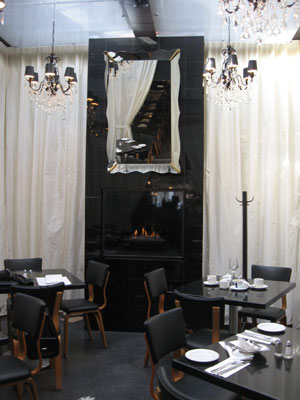
Back dining room at Il Fornello, a great table by the fireplace
After our goodbye I needed to satisfy the growling hunger in my
stomach and I decided to head into Il Fornello which has just recently
relocated to its new location across from the Beaches Library. Il
Fornello is part of a group of about nine restaurants that operate
throughout the city and was honoured as one of Toronto’s Top
Ten restaurants according to the Zagat Restaurant Guide 2006. The
cuisine is upscale Italian and features an extensive menu of appetizers
and salads, pastas and entrees, pizzas and desserts. Weekend brunches
are particularly popular at Il Fornello.
I sat down in the back room which features a large fireplace, and
after a day in the freezing cold I was finally able to warm my frozen
bones. I ordered the Wild Mushroom Pizza with button, shitake, oyster
mushrooms, brie and basil oil: a very tasty lunch-sized meal. On
the side the Insalata Roma with mixed greens, chèvre, roasted
red peppers and roasted walnuts in a balsamic vinaigrette was a
delicious healthy addition to a hungry travel writer’s lunch.
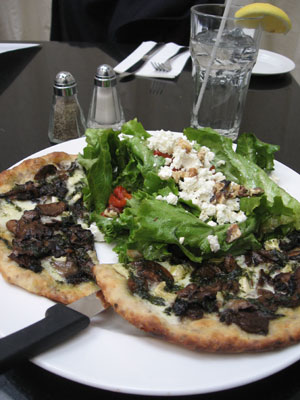
My tasty lunch
Sitting in front of the fireplace I started to relax and reflected
on what a wonderfully diverse and historic neighbourhood the Beach
is. Gene Domagala’s history knowledge and neighbourhood stories
nourished my curiosity; and Il Fornello's tasty lunch nourished
my body.
Who says you have to leave Toronto in order to have a wonderful
travel experience. This was a perfect day of discovery!
Related Articles:
Celebrate Toronto
- An article series to celebrate my chosen home town
Gene Domagala - A human convenience
store of charity and community involvement in Toronto's Beach
Arie Nerman & the Beach Hebrew Institute:
The People's Synagogue
Vivetha Bistro: A popular spot
with eclectic food
Glenn Cochrane - Media
personality, author and expert fundraiser – a champion of
the Beach for almost 40 years
Michelle Gebhart: A
true Renaissance woman: from army brat to expert renovator, biker
lady, successful restaurateur & dedicated youth volunteer
Michael Prue: A working class success
story - from Regent Park to Queens Park
Alex Winch & the
Beach Solar Laundromat – Unstoppable when it comes to championing
renewable energy & innovative entrepreneurship
Mary Lee: A restaurant owner with a heart
for the arts
Marie Perrotta from the Pegasus
Community Project reaches for the stars
Burgie and Benedetta from the Konditor
coffeehouse create Austrian delicacies in Toronto's Beach
Bob Murdoch from Community Centre
55 - 25 years of community service in the Beach
Steve and Paul from Accommodating
the Soul B&B: hospitality with a personal touch
John Dowding: A private lesson in
photography from a true master
Lucille Crighton: A textile
arts Hall of Famer in Toronto's Beach
Lido Chilelli: Founder
of the Toronto International Beaches Jazz Festival
Fire Station 227: History, heroism
and local connections in the Beach
The Green Eggplant: Healthy Mediterranean
food and big solid portions
The Balmy Beach Club - Legend
by the Lake & Toronto's best-kept secret
The Garden Gate Restaurant a.k.a. "The
Goof" - Good food in the Beach since 1952
Ralph Noble: Firefighter,
lifesaver and creator of the most famous mural in the Beach –
a noble man indeed
Sandra Bussin
- City Councillor and Deputy Mayor shows me her neighbourhood
The Toronto Beach Rotary Club:
Service above Self and the joys of volunteering
The Beaches Lions
Club: Charity and community projects in the Beach since 1935
The Beach Business
Improvement Area: A general overview of the Beach and the merchants
and activities on Queen Street East
Maria Minna:
An Italian-Canadian immigrant story and a life-long fight for social
justice
The Beach Metro Community
News: Much more than just the news
The Kingston Road Business Community:
A neighbourhood undergoing revitalization and an integral part of
the Beach
Andrew Smith and Rachel Howard:
Creative entrepreneurs and dedicated community builders
Nevada's Ristorante: Where
hospitality is a family affair
Maria Minna: Another neighbourhood
walk and talk and discoveries along Queen Street East
St. Aidan's Church:The spirit of charity
in the Beach comes full circle
Gene Domagala takes me on a history
tour of the eastern and northern part of the Beach - a perfect day
of discovery
The Beaches Library: A centre
of learning for all ages
A walk along Kingston Road:
A shopping district definitely worth a visit
55 Division: Serving and protecting
- community policing in action
|